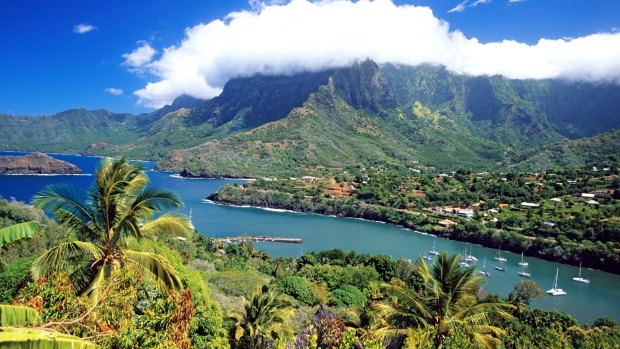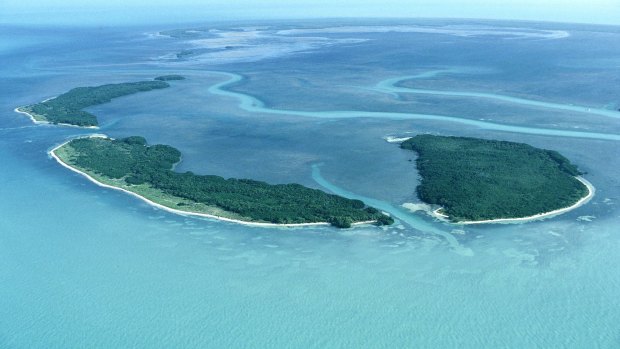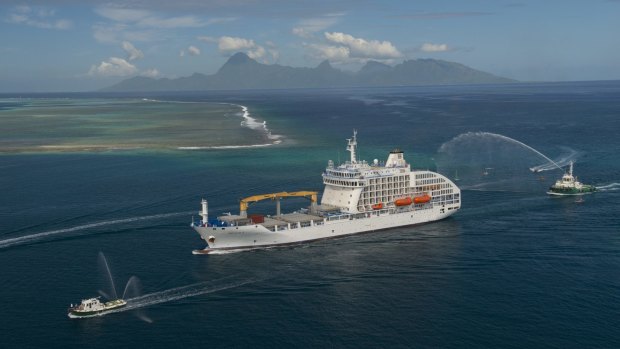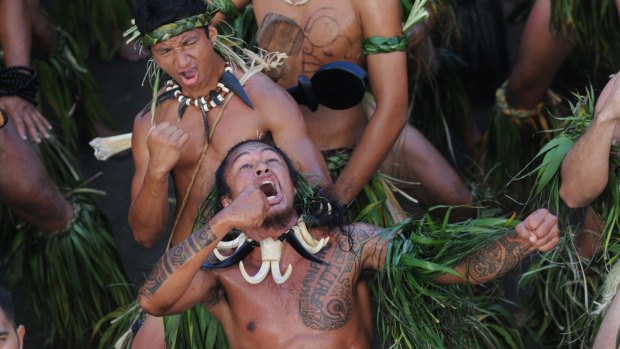This was published 8 years ago
Marquesas Islands, French Polynesia: How to get to the world's most remote islands
By Sue Williams

Hiva Oa is one of six inhabited islands in the Marquesas.Credit: Getty Images
The first outsiders to set eyes on people from the Marquesas – the most remote set of islands in the world – were met by tattooed and war-painted warriors, armed with giant stone and ironwood clubs and slingshots, in outrigger canoes. The visitors were too terrified to leave their ships and venture ashore.
Today, a huge hulk of an equally intimidating Marquesan man, all biceps and rippling muscles under a bold geometry of black tattoos, is part helping, part lifting, me from boat to land with almost heart-stopping delicacy.
"This is my island," he says in Polynesian-accented French, grinning with a flash of dazzling white teeth. "You are very welcome here."

Marquesas Islands, French Polynesia.Credit: Getty Images
So much has changed in the 420 years since the first Spanish explorers refused to anchor at the Marquesas Islands, occupying the far outpost of French Polynesia between Tahiti and Peru. But so much more is still the same.
The islands are still the most isolated land masses on the globe, with their interiors often largely unexplored, matted by dense jungle snaking up the sides of steep volcanic outcrops and plunging into deep crevasses. Their white beaches rarely have anyone on them, and they're still little known by the outside world except for the evocative paintings of Gauguin and the early writings of explorer Thor Heyerdahl and Moby Dick author Herman Melville.
And they're still mostly accessed from the sea.

The Aranui 5 hybrid freighter-cruisers.
This is part of the enduring success of a shipping firm that's been operating a freighter service from the Tahitian capital Papeete to the islands for the past 50 years, to deliver food, fuel and other supplies, and which, 30 years ago, decided to carry passengers, too.
Now, the Aranui series of hybrid freighter-cruisers – they introduced Aranui 5 with its maiden voyage late last year – have become renowned across the world as offering a 14-day expedition to what's considered one of the last true outposts of the world in the company of perhaps its greatest seamen.
It's a world apart from a regular cruise. There are similarities, naturally. The passenger section of the ship is extremely comfortable with most cabins having balconies, and everyone has access to a couple of bars, a coffee shop in the lounge, a small pool on deck, a gym, spa and the restaurant from which breakfast and the three-course lunches and dinners, all with French bread and wine, are served twice a day.

Welcoming party at the Marquesas.
But the Aranui 5 is much smaller than most cruise ships, carrying a maximum of 250 passengers and 100 crew. That makes it a great deal more intimate and relaxed, with plenty of opportunities for actually getting to know the colourful, mostly Marquesan, crew. It includes a descendant from island royalty, unmistakeable with his face and head a startling canvas of traditional tattoos.
A drink in the bar with the crew, listening to them playing drums and ukuleles and singing, as well as watching some perform stunning time-honoured dances, are all unforgettably rich experiences. It can be even more thrilling to actually join in the dances, or to be whirled around the bar (they are very big men!) in a much more modern version.
Another joy is watching the skill with which they unload the 3000 tonnes of cargo they've brought to the islands in the front freighter section of the ship: the post, boxes of frozen food, pallets of cans and fresh provisions, along with the cars, boats, machinery, fridges and even a truck to be delivered. It's equally fascinating watching them on the wharves weighing the local export bags of copra – the dried coconut from which coconut oil is extracted – loading them on to barges, balancing the small mountains of bags and then heaving them up onto the ship.
Quite apart from the vicarious pleasure of watching people work when you're on holiday, it means your ship is welcomed into every harbour of the six inhabited islands – Nuku Hiva, Ua Pou, Hiva Oa, Fatu Hiva, Tahuata and Ua Huka – and by excited locals looking forward to what you're bringing with you.
"I think people come to us because they want to discover the Marquesas with a local crew and a friendly ambience, and they like being part of a freighter and feeling part of the family," says Aranui company CPTM CEO Philippe Wong, whose grandfather migrated from China, married a Papeete-born woman and started the freighter business.
"It also means they feel part of the life of the Marquesas. This ship belongs just as much to the Marquesan people as it does to our company. The locals talk of the Aranui as their 'seventh island'."
It certainly does feel that way, with so many warm greetings at every stop, as well as fabulously perfumed leis and welcoming dances, smiles and handshakes. Passenger Scotty from New Zealand was entranced. "It's like arriving at a gig and being part of the band!" he says.
Excursions on the islands, led by the crew guides, are all part of the voyage, and include tours of ceremonial sites, vast missionary churches, villages, markets, museums and historic tikis and petroglyphs (rock carvings), as well as hikes, fishing and horse-riding trips, demonstrations of traditional crafts, visits to local restaurants and offerings of food cooked in the under-earth traditional oven, the umu.
The life of a freighter itself, however, is endlessly fascinating. As well as a way of transporting goods and passengers around the Marquesas, it's also used by the residents as a ferry between islands, and they sleep in some of the ships' dorms or under a canvas on one of the decks.
At night, you often see people fishing off the side of the ship, dragging in huge warehou or tuna under the lights of the decks, and then roasting them on a barbecue hung over the rail. They'll shout out if there are dolphins dancing alongside, massive six-metre-wide manta rays foraging in the water below, or whales breaching nearby.
One evening there's a Polynesian function, with a magnificent buffet of local foods and specialist dishes, accompanied by an introduction to the crew, dances and music for the guests, who come from all corners of the world, many as repeat voyagers. There are talks by various experts on different facets of the Marquesas and the captain and his officers, as well as the family members who own the Aranui, usually dine informally with everyone else.
Life at sea gradually assumes its own rhythm and arriving at dawn most days to the dramatic cloud-wreathed basalt peaks and emerald green of a fresh new island, or at a different port on the same island, is a highlight.
From the ship, gazing at those vast cliffs and crashing surf over coral in some of the narrow harbour entrances gives you an excellent idea of the natural perils that would have faced the early arrivals at the Marquesas. That's quite apart from the original hostility of a people who protected themselves by looking as ferocious as possible, with tales of cannibalism – apparently they preferred the taste of Englishmen to the French – human sacrifices and the shrunken skull cult as well as elaborate head-dresses and carved stilts to appear taller, and, not least, those tattoos.
These days, it'd be hard to find a safer, friendlier and more welcoming, place in the world, albeit one with such a dangerous, action-packed and bloodcurdling history.
"Tell me, have you ever dropped a visitor into the sea?" I ask the crewman once safely deposited onto his island. He grins again. "Not yet," he replies.
Sue Williams travelled as a guest of Aranui Cruises, Air Tahiti Nui and Tahiti Tourisme
See also: Hard to get to: The world's least-visited destinations
See also: Dream destinations: Australia's 20 best islands
TRIP NOTES
MORE INFORMATION
See www.aranuicruises.com.au ; www.tahiti-tourisme.com
GETTING THERE
Air New Zealand operates frequent flights from Sydney and Melbourne to Auckland, where you pick up a flight with Air Tahiti Nui to Papeete, the Tahitian capital. Flight costs can be included within the Aranui cruise package. Visas are issued on arrival.
STAYING THERE
Prices start at $8689 per person twin share for a 17-night package including a 14-day cruise on Aranui 5 in an ocean view stateroom departing Papeete on May 21, July 2, August 13 or September 24, 2016, inclusive of all meals, shore excursions, and wine with lunch and dinner aboard, plus return economy flights with Air Tahiti Nui from Australia, four nights pre/post cruise accommodation at Manava Suite Resort (with continental breakfast) and Tahiti transfers airport/hotel/ship/hotel/airport, all prepayable air, cruise and hotel taxes and a chauffeur driven luxury car transfer to and from Sydney, Melbourne or Brisbane airports (up to 35 kilometres). To book, contact Ultimate Travel on 1300 485 846.
FIVE OTHER FREIGHTER TRIPS
There are around 45,000 freighters plying the major trade routes across the world each year, and some take passengers. Cabins are often available for single legs of the trips, or round-trips. Meals are usually included in the fares and, while facilities will not be as luxurious as regular cruisers, or the purpose-built freighter-cruiser Aranui 5, you'll usually have a simple cabin with a bed, table and chair, and access to the crew's lounge. Tickets have to be booked six-12 months in advance.
Sydney to California, US, (four to six passengers): 23 days via Tauranga in New Zealand, San Francisco, Los Angeles. A single costs $4165. The round trip, which continues from Los Angeles to Auckland, Melbourne, then Sydney, will take 49 days and costs $7825 per person. www.freighterexpeditions.com.au
Europe round trip from Southampton, UK, (12 passengers): 35 days via Salerno, Piraeus, Izmir, Limassol, Ashdod, Alexandria, Salerno, Savona, Setubal, Bristol, Cork, Wallhamn, Esbjerg and Antwerp back to Southampton. Single from $3600. www.freightertravel.co.nz
Brisbane to Hong Kong (four cabins): 21 days via New Zealand's Auckland, Port Chalmers, Lyttleton (Christchurch), Napier, Tauranga and then Noumea, Hong Kong. Single, $4725. The round trip, which continues via China and Taiwan to Brisbane, will be an extra 21 days, $6730. www.freighterexpeditions.com.au
Kuala Lumpur to China and back (10 passengers): 25 days via Port Kelang to China's Xiamen, Qingdao, Shanghai, Ningbo, Yantian and Chiwan, and then Vietnam's Vung Tau. From $4200. www.freightertravel.co.nz
New York to Argentina (two cabins): around 25 days via Baltimore and Savannah in the US, the Bahamas, Dominican Republic, Santos in Brazil and Buenos Aires. Single $4200. The round trip, which continues to Uruguay's Montevideo, Brazil's Rio Grande, Santos, Salvador and Suape, then the Bahamas, Norfolk in West Virginia to New York, takes 56 days, $9450. www.freighterexpeditions.com.au
Sign up for the Traveller Deals newsletter
Get exclusive travel deals delivered straight to your inbox. Sign up now.